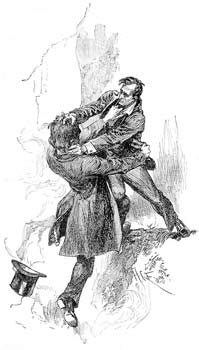 |
The
Case of the Resurrected Detective: "The Empty House"
| |
| "An
examination by experts leaves little doubt that a personal
contest between the two men ended, as it could hardly fail
to end in such a situation, in their reeling over, locked
in each other's arms."
|
By 1893, Arthur Conan Doyle
had written 24 stories and two novels about the great consulting
detective, Sherlock Holmes, and his chronicler, John Watson. Conan
Doyle's other works, while successful, did not approach the success
of the Holmes stories. Conan Doyle had long been tempted to kill
off his most famous character so that he, and the public, could
focus on what he considered to be his most important work.
Once "The Final Problem" had been printed and sold to an unsuspecting
public, Conan Doyle was shocked by the vehemence of the public reaction,
which included threats and abusive letters. "You Brute!" one letter
began. According to one possibly apocryphal story, a lady attacked
him with her umbrella when she met him in the street; another picketed
his house in protest. People wore black armbands as if a real celebrity
had died. Apparently, Conan Doyle was the only one who took his
famous detective less than seriously, and he had his reasons.
During the year that preceded the December death of Holmes, Conan
Doyle's father had died, and his wife had been diagnosed with a
particularly virulent form of tuberculosis, and was only expected
to survive for a few months. "I have been much blamed for doing
[Holmes] to death," Conan Doyle said in a speech, "but I hold that
it was not murder, but justifiable homicide in self-defense, since,
if I had not killed him, he would certainly have killed me." During
a sojourn in the Swiss Alps with his wife at a sanatorium for tubercular
patients, Conan Doyle determined upon the method of Holmes's death.
As 1893 came to a close, Conan Doyle's wife Louise began the cure
that would allow her to live for 13 more years, while Sherlock Holmes
(apparently) died. "Killed Holmes," Conan Doyle wrote in his diary,
and went on with his life.
Conan Doyle was finally inspired to write The Hound of the Baskervilles
in 1901 and a series of Holmes stories for The Strand (beginning
in 1903 with "The Empty House") by an offer he could not refuse:
The Strand and the American magazine Colliers
offered him more money than he had ever been offered for his writing
before. Discovering Sherlock Holmes will begin with "The
Empty House" when our next series starts in early 2007.
|







